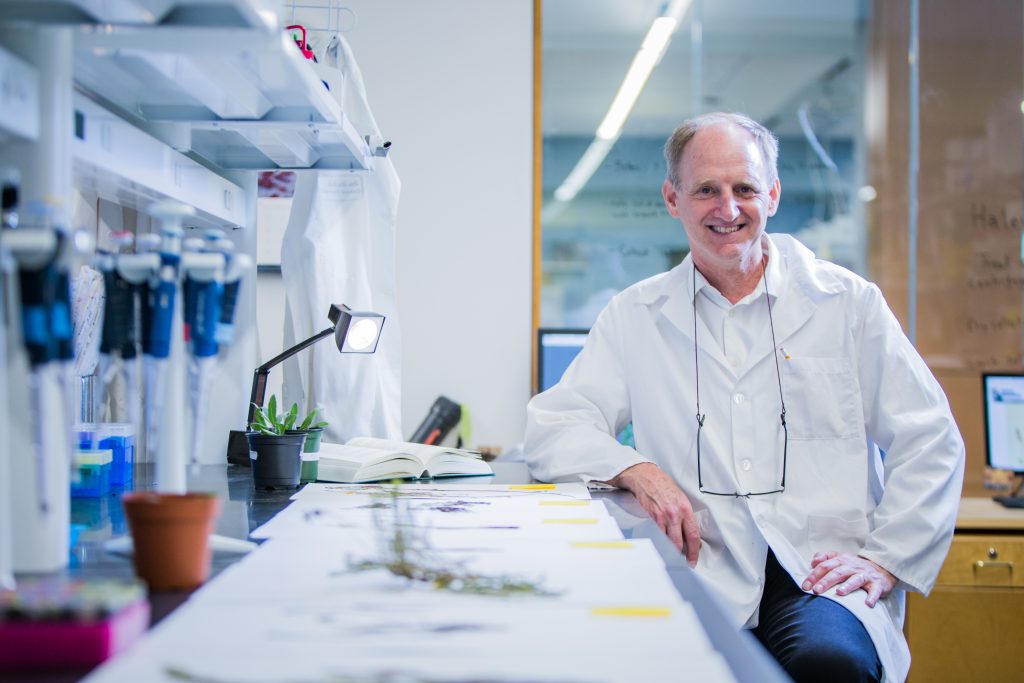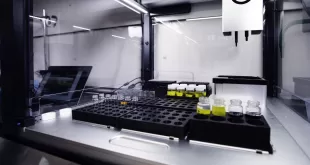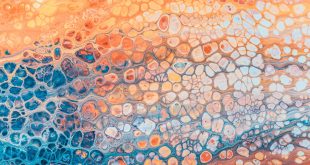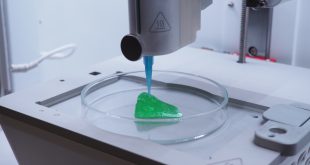By TREVOR KENNEY

Southern Alberta’s vast prairies can often be harsh and unforgiving. Windswept and prone to temperature extremes of 35 C during baked dry summer months and -35 C in the bone-chilling winter, its landscape is still surprisingly rich in flora, producing an array of hearty plants that are just now being recognized for their unique properties of medical importance.
Dr. Roy Golsteyn, whose laboratory is in the $280-million Science Commons building at the University of Lethbridge, has been investigating the medicinal properties of the prairie plants that dot this unique setting for nearly a decade. It is slow, methodical work for the biological sciences professor and researcher, but the potential he and his team see is limitless.
“People think of Canada as cold and ice and snow and they don’t look at Canada as they do the tropical regions where historically a lot of this type of work has been done,” says Golsteyn, who heads a small but robust eight-person lab. “This area has escaped notice, but we’re changing that.”
Golsteyn’s Prairie to Pharmacy research program began taking shape in the summer of 2013 when he and Dr. Sophie Kernéis (now at Lethbridge College) started to create the plant and extract collection. Golsteyn, who previously worked in the pharmaceutical industry, was keen to explore the chemical compounds from the region’s prairie plants. He recognized that many of the plants in southern Alberta were actually quite toxic — a necessity for their survival in a difficult climate with a short growing season and multiple grazers (deer, antelope, buffalo, cattle) seeking nourishment.
Getting people to take notice of this, however, was a slow process, and one that required extra effort at each step. While convinced he had at his disposal a number of extracts that showed great promise in their ability to inhibit cell growth — specifically cancer cells — the fact that nobody had previously studied these plants acted as an obstacle. He could not build off of previous work; rather, he and his group had to lay the groundwork themselves. It meant running tests, writing papers, securing funding and gaining acknowledgment from peers, donors and research partners that this was a viable path of study.
“It has taken more time than I anticipated, but we have moved forward, and this year has been a big year because we’ve had five publications on four different Canadian plants in peer-reviewed journals,” says Golsteyn. “It’s a first for almost all of these plants and now we’re sharing this with the scientific world, all the tremendous chemicals and the activities of these plants from right here in our area.”
Golsteyn’s lab itself is an impressive representation of the scope and focus of Science Commons. Described as a building that puts science on display, Science Commons presents the Prairie to Pharmacy program to anyone walking the corridors of the ninth floor. Its all-glass frontage allows inquisitive passersby to watch Golsteyn and his teammates conduct work on their plants, with many cultivars dotting the various lab benches. The open laboratory concept permits better use of specialized equipment such as fluorescence microscopes, high pressure liquid chromatography (HPLC) and automated cell imagers such as the Cytation 5. In all, he and his team have access to more than 1,200 sq.ft. of lab space, including the plant library itself, which measures 122 sq.ft.
“We have one of the few prairie plant libraries around, and it now contains 148 different species with over 500 extracts,” says Golsteyn. “Many of these species are very difficult to find elsewhere in the world, and lately we’ve been able to start distributing them to other universities and institutes. We’ve recently sent extracts to the University of Alberta, University of British Columbia, an institute in Belgium that studies malaria, and another institute in Switzerland.”
One of the first plants to interest Golsteyn and his research group was Thermopsis rhombifolia (buffalo bean). Virtually from the outset, it displayed potential anti-cancer activity by inhibiting an enzyme essential for cell mitosis, or the growth of cancer cells. In their recent paper published in the Journal of Natural Health Products Research, Golsteyn’s group says, “It is noteworthy that natural products are the major source of modern medicines, and that these chemicals are invaluable tools with which to investigate cellular pathways.”
The group’s work reveals that the isolation of the natural product luteolin from the buffalo bean was able to inhibit the enzyme Cdk9 (cyclin dependent kinase) and its role in cell mitosis. Further, it arrested cells in the G1 phase of the cell cycle, thereby not allowing cancer cells to replicate. Although luteolin is from a class of chemicals that are unlikely to become a medicine, it has excellent properties as a safe and inexpensive reagent to study how cancer cells divide.
Golsteyn’s group has been directing much of its efforts on a plant showing great promise: Gaillardia aristata (Asteraceae). In collaboration with Dr. Raymond Andersen’s team from the University of British Columbia, they discovered pulchelloid A, a natural product present in Gaillardia aristata that arrests human cancer cells in mitosis. Cells enter a prolonged mitotic arrest in which the spindles become multi-polar and the chromosomes acquire gamma histone H2Ax, a hallmark of damaged DNA. The novel mechanism of action has led to new studies ranging from harvesting related plants to transcriptomics, metabolomics and confocal microscopy, both at the U of L and with collaborators in Canada and Europe.
If real estate is all about location, location, location, Golsteyn’s lab is living proof of that concept. Science Commons and the U of L are nestled in the coulees of the Oldman River valley, allowing Golsteyn and his team to literally walk out the door and harvest cultivars. Some of their most recent work has taken them just an hour or so away, to the foothills of the eastern slopes of the Rocky Mountains. In fact, more than half of all plant species in the entire province of Alberta lie within a 90-minute drive from the university’s front doors.
Some days, his group simply scours the area for interesting plant species, while other days see tips coming in from area farmers and ranchers. The university’s longstanding relationship with local Indigenous leaders, particularly the Blackfoot people, has led to unique approaches to studying plants from this region. All plant collections are undertaken sustainably and with permits in order to protect this valuable and fragile ecosystem.
“The university had a very positive relationship with the First Nations communities long before we started our project,” says Golsteyn, who describes his research program as taking two parallel approaches.
“There’s the classical Western scientific approach I’m trained in and that’s done all over the world where we’ll take a plant and look at it with a scientific view,” he says, noting all plant collections include a tobacco offering at the time of harvest. “At the same time, we will approach things using traditional First Nations knowledge, but we only do that if a member of the First Nations community is in the lab and can undertake the additional responsibility. Fortunately for us, we draw some excellent First Nations students who are excited and connected to the work and can share traditional knowledge with our group.”
While it took some time to cultivate support from funding agencies, once the work began it quickly garnered attention. Now supported by major granting agencies such as the Natural Sciences and Engineering Research Council of Canada and the Canada Foundation for Innovation, the Prairie to Pharmacy program has been supported generously by private donors as well possibly, Golsteyn says, because it resonates with them.
“Unlike some of the other projects I’ve worked on, people connect more easily to the science of natural products,” he says, noting his role is to fundamentally identify and preliminarily test compounds before teaming with pharmaceutical companies to pursue drug development. “It’s pretty hardcore science, but fortunately people are interested in it, and they share our vision, they’re able to make the connection between our prairies, the plants and the medicines.”
It’s why Golsteyn regularly receives tips from area landowners about plants on their properties whenever his lab makes the news. They’ll see a plant on their land that animals will not go near and understand it might have some chemical properties that deserve to be studied. It’s also why students are eager to be a part of his lab and engage in the work.
“We’ve had some students who have been with us throughout their entire time here at the U of L,” says Golsteyn. “They usually go on to either study medicine, because there has been a renewed interest in natural products in medicine, or find their way into biotech companies. I see my laboratory and our university as a launchpad for students seeking exciting scientific opportunities in natural products.”
Golsteyn recognizes that despite a decade of work, he and his group are only just beginning to understand what properties many of these plants possess. With guidance from First Nations knowledge keepers, global collaborators, an ideal location and a new, state-of-the-art lab, they are excited to see what future discoveries await in natural products.
 BioLab Business Magazine Together, we reach farther into the Canadian Science community
BioLab Business Magazine Together, we reach farther into the Canadian Science community





